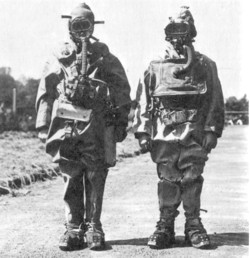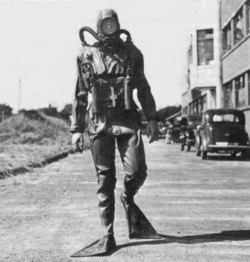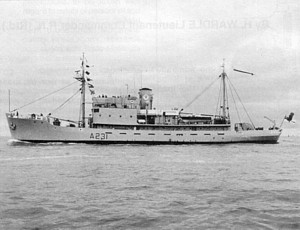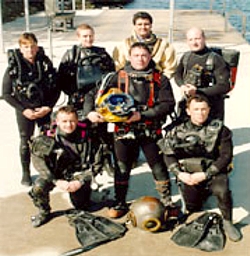


Clearance Diving takes its name from the operations carried out towards the end and after the Second World War to clear the ports and harbours of the Mediterranean and Northern Europe of unexploded ordnance and booby traps laid by the Germans. This work was undertaken by RN Rendering Mines Safe (RMS) and Bomb Disposal Units and later by Port Clearance Parties or ‘P’ Parties, two of which (Naval Parties 1571 and 1572) went into action soon after D-Day to clear the vast quantities of unexploded ordnance and general debris left after the Allied invasion. They were joined later by other ‘P-Parties' including 'P-Parties' 1573, 1574, 1575 and 2444 (many of which had Commonwealth naval personnel) and 'P-Party' 3006 manned by the Dutch. The 'P-Parties' were formed under the Admiralty's Director of Minesweeping because they were, in effect, a form of minesweeping. On 1 October 1944, all Royal Navy diving, including the 'P-Parties', was transferred to the Director of Torpedoes and Mining.
Work in the European theatre continued until well after the end of the war. Most of the 'P-Parties' were disbanded, together with HMS Vernon(D) at Brixham, on 30 November 1945. The exceptions were 'P-Party' 2444, which was still operating at Dunkirk, and 'P-Party' 2443 which had been formed in June 1945 to deal with residual suspected unexploded ordnance around the UK coast after the war and became based at HMS Vernon, Portsmouth.
'P-Party' at work
Members of RN RMS and Bomb Disposal Units and the later ‘P-Parties' were among the most highly decorated of the war. While the RMS and Bomb Disposal Units suffered many grievous casualties, not a single member of a ‘P-Party' was lost in action although AB William Brunskill died of wounds after a German V-2 rocket hit the Cinema Rex in Antwerp where he was watching a film on 16 Dec 1944. All this was despite having cleared the ports of Cherbourg, Caen, Dieppe, Le Havre, Boulogne, Rouen, Calais, Antwerp, Ostend, Terneuzen, Zeebrugge, Flushing, Amsterdam, Rotterdam, Hamburg, and Bremen. Sixty mines were cleared at Bremen alone. Lt Cdr Lionel ‘Buster’ Crabb was one of those involved in clearance operations in Italy having seen success against the limpet mines placed on ships in Gibraltar harbour by Italian charioteers operating from a ship interned across the bay in Algeceiras harbour. On 19 April 1956, he was to disappear in mysterious circumstances when the Soviet cruiser Ordzhonikidze brought Khrushchev and Bulganin to Portsmouth.

WW II Clearance Diver in 'P-Party' Mk II suit & Charioteer in
Mk II Human Torpedo Sladen 'Clammy Death' suit that eventually became
the RN's Shallow Water Diving Dress. Both used pure oxygen.
OTHER NAVAL ORGANISATIONS
Other
naval organisations that made a contribution to the CD Branch included:
Standard Divers. These ‘professional divers’ of pre-war days were trained at the Gunnery School at HMS Excellent in Portsmouth. Among other things, they carried out much research and experimental work in conjunction with eminent scientists such as Sir Robert Davis of Siebe Gorman and Professor J S Haldane for the furtherance of diving knowledge. Officers and sailors, mainly from the Gunnery Branch, became Qualified Deep Divers. They served in the Fleet as Clearance Divers for some time after the war but were gradually phased out or transferred to the CD Branch.
Early RN Standard Diving
Admiralty Experimental Diving Unit. The AEDU was formed in 1942 under the command of the first RN Superintendent of Diving, a submarine officer from HMS Dolphin, Lt Cdr (later Capt) W O 'Bill' Shelford. The unit was based at the Tolworth, Surrey works of Siebe Gorman and Co Ltd and a close partnership was formed during the war years. Here, all the diving equipment was developed for human torpedoes (chariots), midget submarines (X-craft), mine recovery parties and, later, for the ‘P’ Parties. An exhaustive programme of human experiments was conducted on oxygen diving and other physiological problems associated with diving with Professor J S B Haldane (son of J S Haldane) acting as the adviser. AEDU continued to perform its work at HMS Vernon until shortly before its closure.
The Mining Department and the Mine Design Department of HMS Vernon. In 1876, the newly commissioned HMS Vernon became responsible for the development and disposal of sea-mines. During the Second World War, the Mining Department was set up under the Director of Torpedoes and Mining at the Admiralty with responsibility for the recovery of enemy mines, both above and below water. Rendering Mines Safe (RMS) teams were responsible for the disposal of unexploded mines. Recovered mines were exploited by the Mine Design Department to discover how they worked and, thereby, how they could be swept or countered. On 1 October 1944, responsibility for naval diving passed from the Gunnery Branch to the Torpedo Branch whereupon the Director of Torpedoes and Mining assumed responsibility not only for diving equipment but for the co-ordination of training as well.
Landing Craft Obstacle Clearance Units. The ‘LCOCUs’ were a vital part of the D-Day invasion forces in Normandy. Four Royal Navy and six Royal Marines units comprising 120 divers wore newly developed neoprene suits with 'blast proof' kapok jackets underneath, helmets, breathing apparatus and fins. They laid the foundations for the Very Shallow Water (VSW) and beach clearance techniques in use today. Those remaining after the war were eventually incorporated into the Clearance Diving Branch.
Naval Bomb Disposal Teams. By 1939, concurrently with the formation of Royal Engineer Bomb parties, the Admiralty and Air Ministry had set up their own separate and distinct Bomb Disposal organisations, each with an exclusive responsibility to its parent service. In August 1940, the UK Joint Service Bomb Disposal Charter was raised to outline and establish inter-Service responsibilities for UK Explosive Ordnance Disposal. Naval Bomb Disposal Teams were set up under the Directorate of Naval Ordnance under the Director of the Naval Unexploded Bomb Department (DUBD) to discharge the Royal Navy’s responsibility for dealing with unexploded bombs on its own property. By 20 September 1940 there were Naval bomb disposal teams at 27 shore establishments. Each team was led by a BSO (Bomb Safety Officer) who was normally a Sub Lieutenant RNVR or Commonwealth equivalent of the RNVR.
One of the BSOs was an American called Draper L Kauffman. He graduated from the US Naval Academy in 1933 but retired to civilian life because of weak eyesight. In 1939 he joined the French Ambulance Service and was captured by the Germans when they overran Holland and Belgium. Upon his release as a citizen of a neutral country (USA), he joined the Royal Navy as a Sub Lieutenant RNVR (Royal Naval Voluntary Reserve) and was trained as a BSO. He performed bomb disposal duties for 14 months until October 1941 when, following an accident, he returned on leave to Washington. Here, he was approached by the US Bureau of Ordnance and asked to establish a US Bomb Disposal School. Thus, Lt D L Kauffman RNVR became Lt D L Kauffman USNR and Officer-in-Charge of the first US Bomb Disposal School. He was subsequently awarded the Navy Cross for bomb disposal work at Pearl Harbour and finally retired from the USN as a Rear Admiral after establishing the US Navy's first Underwater Demolition Teams (UDTs), the forerunners of the Sea, Air, Land Teams more commonly known as the SEALs.
In September 1944, the duties performed by DUBD were taken over by the Director of Torpedoes and Mining (DTM), the new department thus formed being known as DTM (Bombs and Mine Disposal Section). This new branch, based at HMS Vernon, thus controlled the BSOs (Bomb Safety Officers), the RMS (Rendering Mines Safe) personnel (who were already an integral part of DTM) and the Land Incident Section.
X-Craft and Chariot Crews. These belonged to the Submarine Branch but the crews were required to train as divers. Much of the work devoted to their training and to the development of their equipment was conducted by AEDU and contributed to the diving techniques and equipment in use today. X-Craft, with divers embarked for cutting through defensive nets and attaching limpet mines, attacked the German battleship Tirpitz in Norway in September 1943 and were also used successfully in the Far East. British charioteers operated in the Mediterranean and the Far East.
THE END OF THE WAR
With the end of the war, Vernon(D) at Brixham was closed on 1 Oct 1945 and ‘P-Party' 2443 moved its headquarters to HMS Vernon at Portsmouth but only for a short period. It was decided to integrate the ‘clearance’ divers more closely with the mine countermeasures establishment at HMS Lochinvar in Port Edgar on the Firth of Forth and this is where the members of the last ‘P’ Party on the Continent ('P-Party' 2444) were sent in March 1946 after having cleared Dunkirk. In the meantime, HMS Vernon became the centre for Deep Diving and AEDU moved here from Siebe Gorman at Tolworth. Something of a division then sprang up between the deep divers at Vernon (the ‘Steamers’) and the Clearance Divers at Lochinvar (the ‘Corkheads’).
FORMATION OF THE CLEARANCE DIVING SPECIALISATION
In 1950, a Home Station Clearance Diving Team was set up and other Clearance Diving Teams were soon established to support the Mediterranean Fleet and the Far East Fleet. In 1951, clearance diving training moved from Lochinvar to Vernon and a new Clearance Diving School was established combining the training of clearance divers with that of ‘deep’ divers. This school also took on the new task of training Shallow Water Divers (later called Ships’ Divers) so that every ship had a properly equipped air diving capability under its own Diving Officer to conduct ship’s bottom searches and undertake simple underwater engineering tasks.

British 'frogman' wearing Dunlop Underwater
Swimming Breathing Apparatus (UWSBA)
On 3 December 1948, 'P-Party' divers were officially renamed Clearance Divers in accordance with Confidential Admiralty Fleet Order 341/1948. On 7 March 1952, the Clearance Diving (CD) specialisation, under the auspices of the TAS Sub-Branch of the Seaman Branch, was officially introduced under Admiralty Fleet Order (AFO) 857/52 although a training nucleus had been set up some two years earlier to take advantage of the few remaining men with wartime experience. These officers and ratings had, in the main, qualified as Shallow Water Divers trained to use the Sladen ‘Clammy Death’ diving dress and oxygen breathing apparatus. They were joined by other officers and ratings Qualified in Deep Diving (QDD).
On 25 February 1966, the Minewarfare and Clearance Diving (MCD) Sub-Specialisation of the Seaman Branch was formed in accordance with Defence Council Instruction 278/66. Seaman Branch officers already qualified as CD and TAS automatically became MCD Officers while those qualified only as CDOs undertook a conversion course to be trained in Minewarfare, until then, the prerogative of TAS Sub-Branch officers. TAS (UW) and (UC) ratings of the Seaman Branch continued to perform Minewarfare duties until 1975 when the Minewarfare (MW) Sub-Branch of the Operations Branch was formed together with the Diver (D) Sub-Branch. In 1981, the MCD Sub-Branch of the Operations Branch took over responsibility for demolitions training from the Sonar (ex-TAS UC) Sub-Branch.
DEEP DIVING

HMS Reclaim paying off
In June 1948, HMS Reclaim entered service and was to be the RN’s deep diving tender for the next quarter of a century. Almost immediately, she grabbed the world’s headlines when, within two months of commissioning, Petty Officer Wilfred Bollard claimed the world deep diving record at 535 feet. She went on to undertake several more headline grabbing tasks by finding, and often assisting in the deep salvage of various submarines (including HMS Affray in April 1951), aircraft, helicopters and weapons lost during trials. On 12 October 1956, Lt George Wookey RN dived from HMS Reclaim to set a new deep diving record of 600 feet in Sorfjord, Norway. The CD branch retained a deep diving capability using the venerable Deep Diving & Submarine Rescue vessel HMS Reclaim, the chartered diving support vessel MV Seaforth Clansman and the short-lived Seabed Operations Vessel HMS Challenger as saturation diving platforms for NP 1007 until the early 1990s when naval deep diving was abandoned because it became more cost-effective to use commercial resources when required.
Left: MV Seaforth Clansman
Right: HMS Challenger
OTHER ACHIEVEMENTS
The CD Branch has been kept active throughout its existence. The Mediterranean CD Team undertook the clearance of WWII ordnance in Grand Harbour, Malta. During Operation Rheostat in 1974/5, the Fleet Clearance Diving Team worked with RN MCMVs to clear the Suez Canal of ordnance and other military debris following the Arab-Israeli 6 Day War. The final tally included 209 tons of TNT bombs of various sizes, about 800 ant-tank and anti-personnel mines, 6,000 rounds of ammunition and 70 various missiles. During Operation Hemicarp in 1977, RN CDs co-operated with their US counterparts to clear ex-US and Japanese WW II ordnance from the waters of Tarawa and Tuvalu in the Gilbert and Ellis Islands. On a more peaceful note, 35 RN CDs worked with 18 Egyptian divers in 1977/78 to shift 16,000 tons of mud and 320 blocks of stone during the movement of important Egyptian monuments submerged by the construction of the Aswan Dam to a site replicating Philae on Agilkia island.

1990s RN Diving Equipment including old CDBA
CD teams worked in particularly arduous conditions conducting bomb and mine disposal during Operation Corporate in the Falklands in 1982 and in the Red Sea during Operation Harling in 1984. In 1987, they cleared Iranian mines in the Gulf of Oman and in the Persian Gulf during Operation Cimnel. In 1991, they were back in the Persian Gulf during Operation Granby, this time clearing hundreds of Iraqi mines laid off the shore of Kuwait. Most recently, CDs embarked in RN minehunters were involved in Operation Allied Harvest (the clearance of allied bombs jettisoned in the Adriatic during the Bosnian and Kosovo conflicts) in 2000, and Operation Cleanex (the clearance of wartime ordnance in the Baltic) in 2001.
RN Diver in modern Clearance Diver
Life Support Equipment (CDLSE)
RN CDs were again in action to clear the Shatt-al-Arab and Khawr abd Allah waterways into the port of Basra during Operation Telic, the war that deposed Saddam Hussein of Iraq. They remained in Iraq after the war to complete the clearance of Iraqi ports, conduct joint service EOD and search for weapons of mass destruction. Accounts of this activity can be found in the News Archives for 2003. They are currently serving with EOD and IEDD teams in Afghanistan.
Today, CD units remain busy around the country conducting explosive ordnance disposal, usually of wartime ordnance washed up on the beach or hauled up by fishing vessels, complex underwater engineering tasks on ships and submarines, search and recovery operations and many other tasks as well as providing Military Assistance to the Civil Powers (MACP) for such tasks as Improvised Explosive Device Disposal (IEDD) and Maritime Counter Terrorism (MCT). Clearance diving elements are also embarked in mine countermeasures vessels (MCMVs) as an integral part of the weapons system for mine disposal. Perhaps uniquely in the RN, members of the CD Branch perform their hazardous wartime role of dealing with live ordnance on a daily basis even in peacetime. Use these links to download information from the Royal Navy website about becoming a Warfare Officer (including Mine Clearance Diving Officer) or a Mine Clearance Diver Specialist Rating.
The author's final dive in the Royal Navy (July 2002)
Biblography:
BR 2806 Vol I - RN Diving Manual
BR 5063 - Clearance Diving Handbook
A Diver in the Dark by Sydney Knowles
All Mine! by Lt Noel Cashford MBE RNVR
All Theirs! by Lt Noel Cashford MBE RNVR
BANG by Lt Noel Cashford MBE RNVR
Bomb Disposal and the British Casualties of WW2
by Chris Ransted
By Sea and by Stealth by Burke Wilkinson
Chariots of the Sea by Pamela Mitchell
Combat Frogmen by Michael Welham
Courage Beyond Duty by Lt Noel Cashford MBE RNVR
Deep Diving & Submarine Operations by Sir Robert H Davis
Designed to Kill by Major Arthur Hogben
Desert Sailor: A War of Mine by James T Hewitt
Dive Navy by Lt Cdr Harry Wardle RN
Diver by Tony Groom
Divers and Diving by Reg Valentine
Forecastle to Quarterdeck by Lt Cdr Harry Wardle RN
Frogman V.C. by Ian Fraser
Full Fathom Five by Peter Lunn
HMS VERNON - A Short History from 1930 to 1955 by Cdr E D Webb RN
In at the Deep End by Bernard Breakell
Men Under the Sea by Egon Larson
Open The Ports; The Story of Human Minesweepers by J Grosvenor & Lt Cdr L M Bates RNVR
Raiders from the Sea by John Lodwick
Secret Naval Investigator by Cdr F Ashe Lincoln QC RNVR
Service Most Silent by John Frayn Turner
Shore Establishments of the Royal Navy
by Lt Cdr Ben Warlow RN
The Explosive Years - Exploits of a RN B&MDO, 1940-1946 by Lt Bert
Blackmore RNVR
The Frogmen by James Gleeson & Tom Waldron
The Hidden Menace by Lt Cdr Maurice Griffiths GM RNVR
The Sea our Shield by Captain W R Fell CMG, CBE, DSC RN
The Torpedomen by Rear Admiral E N Poland CB, CBE
Ticking Clock! by Lt Noel Cashford MBE RNVR
To Render Safe by Lt Colin Churcher MBE RN
Underwater Saboteur by Max Manus
Underwater Warriors by Paul Kemp
Back to History of RN Minewarfare & Clearance Diving